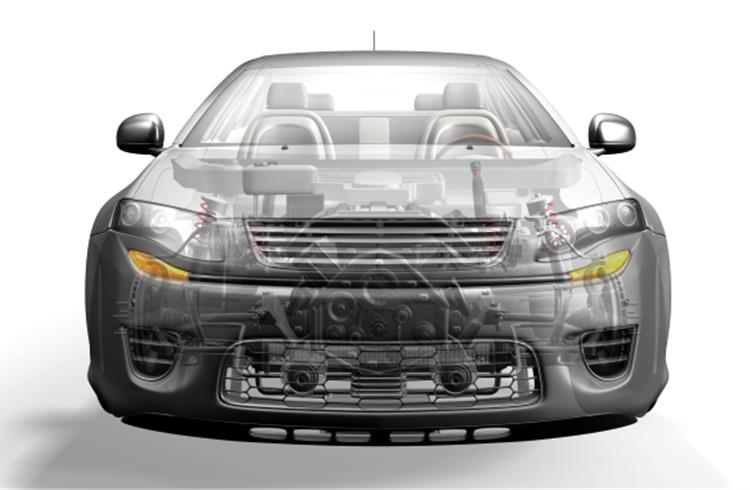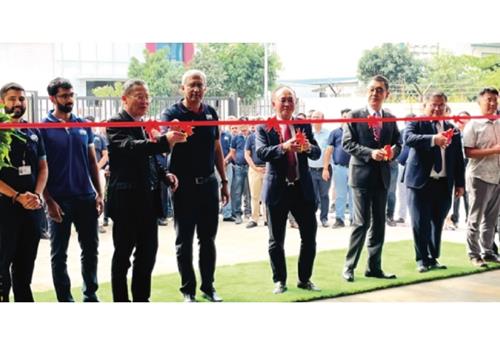Lanxess takes the hybrid tech route to replace metal
Is plastic a better material than metal for automotive? Along with its Durethan & Pocan high-performance plastics, Lanxess' plastic-metal hybrid tech facilitates intelligent lightweight construction.
The world over, the automotive industry is facing increasing restrictions on CO2 emissions as well as safety norms, challenging OEMs and component suppliers to develop lighter but stronger vehicles. This has also led to a quest for the use of innovative materials and new technologies which are climate-friendly.
Lanxess India, the wholly owned subsidiary of specialty chemicals company Lanxess Deutschland GmbH, which offers lightweight solutions and technologies for automotive, is bullish on the Indian automotive market’s growth potential. Armed with its global expertise and localisation strategies, the company has been working with key OEMs and suppliers. It has a wide range of high performance materials under the Durethan, Pocan and Tepex brands that help develop solutions to make vehicles lighter and also safer.
Lanxess’ high performance materials (HPM) business unit is one of the leading suppliers of high-tech plastics for the automotive industry. In India the company has been importing materials from its German plants. In 2012, the company opened a greenfield facility in Jhagadia, Gujarat. With an annual capacity of 20,000 tonnes, it is one of the biggest engineering polymer compounding plants in India.
Speaking to Autocar Professional, Pankaj Khare, head, sales and marketing India and ASEAN region, High Performance Materials Business Unit, Lanxess India, says, “Our hybrid technology combines plastics with metals, which has already been implemented in several vehicle models worldwide. This technology thus constitutes intelligent lightweight construction with outstanding component properties, which reduce fuel consumption and CO2 emissions.”

The HPM compounding plant in India produces Durethan engineering plastics based on polyamide 6 and 66 and Pocan, engineering plastics based on polybutylene terephthalate. This unit offers a wide variety of Durethan and Pocan grades which are used for both automotive and non-auto applications. Durethan and Pocan are widely used to manufacture technically demanding components that comply with the highest specifications in terms of load resistance, functional reliability, and long-term performance.
“We cater to the engineering polymer requirements of almost all the OEMs and Tier 1s present in India and are contributing to development and production of many demanding applications like air intake manifolds, oil modules, door handles, oil pans, coolant water pipes, fuel tanks, thermostat housing, fuel rail, roof frames and pedal modules,” says Khare.
The India plant also exports Durethan and Pocan to other APAC countries including Japan and Korea. Given the high potential in India, the company foresees the local market catching up rapidly over the next three to five years.
Making vehicles lighter
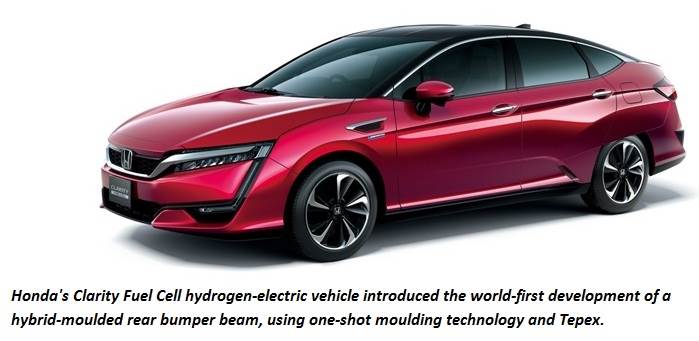
As automakers take to lighter materials, engineering plastics are enabling weight reduction without adversely affecting other physical properties such as mechanical strength.
Lanxess says its lightweight solutions and technologies for the auto industry have proven themselves in various applications worldwide. This has resulted in development of a hybrid moulding process for making large components out of its injection moulding compounds in combination with glass fibre composite materials, facilitating weight reduction of 25 to 50 percent compared to the similar metal solution and a significant streamlining of the production process.
“We have converted many applications like front end modules and oil pans from metal to plastic. A good example of our expertise in lightweight construction is the front end carrier of the new Skoda Octavia in Europe. It is made from a highly reinforced Durethan grade with 60 percent glass fibre, and from polyamide 6 portfolio. While working on such innovative applications, we work closely with our customers right from concept stage till end product,” says Khare.
Growing usage
The message of lightweighting in gradually spreading and the trend of manufacturing engine oil pans from plastic instead of metals such as aluminium is continuing to gain ground. Newer designs are favoring polyamide 6, an alternative that offers a similarly high-quality property profile but is much more economical.
The latest design of this type is the oil pan module for the new six-cylinder Boxer engines of the Porsche 911 Carrera, which is being manufactured using Durethan. This is a big success as the component fully satisfies the specific requirements for functional integration, lightweight construction and cost-effective production that the new generation of engines require. Also, Lanxess has helped Audi in its new flagship A8 model. The plastic-metal hybrid technology developed by Lanxess is used in the front end of Audi’s new top-of-the-range model. The component is a beam in the engine compartment to which, for example, radiator and headlight assemblies are attached. Additionally, the spare wheel recess with integrated reinforcing hollow channels in the new Audi A8, is made of Durethan DP BKV 60 H2.0 EF, a highly filled polyamide 6 from with 60 percent glass fibres. This polyamide 6 is the material of choice because it enables precise injection moulding of the part’s complex geometry.
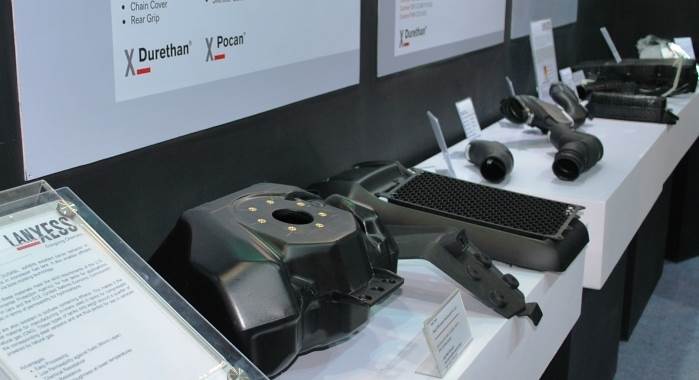
Both Durethan and Pocan special compounds offer high UV resistance and high impact strength for injection moulded and blow-moulded two-wheeler applications.
Lanxess through its application development centre in Hong Kong supports customers and industry partners in Asia in parts development and qualification for successful launching of new applications and plastics parts. The centre helps evaluate the reliability, performance and compliance of prototype parts and mass production parts according to customer engineering specifications.
India has a large two-wheeler market where a good number of OEMs are taking to substituting metal with plastics. “Our first single-layer blow moulded PA6 fuel tank for two-wheelers was developed last year in India for Bajaj KTM and the requirements were very unique because Bajaj KTM was to export these bikes to US where EPA (Environmental Protection Agency) norms on permeability were so stringent that normal fuel tanks in HDPE could not serve the purpose,” reveals Khare.
Lanxess’ Durethan BC 550Z 900116 DUSXBL not only suited the specification but also offered a higher impact strength, excellent mechanical properties, high processability and good mechanical strength.
As Indian automakers take to employing the latest hi-tech manufacturing techniques and materials, high-tech performance polymers are showing them the way to both shed weight but also stay strong.
INTERVIEW Pankaj Khare, Head, Sales and Marketing – India & Asean, Lanxess India
How much weight reduction is possible with high-performance polymers?
Weight reduction depends on various factors such as design, thickness, the processes and integration opportunities among other things. However, in general, between 15-40 percent reduction in weight is possible.
How long are the product development periods?
The product development cycle in the automotive field is long. For example, if we start working on a project this year, the launch of the vehicle may be in the year 2018-2019. Roughly, it’s an around 24 months’ cycle.
What are the cost implications when a product changes from metal to polymer?
Generally, cost reduction happens through the integration of various parts that we do. So integrated products cost much lesser than metal components. This not only helps in weight reduction but in cost reduction as well.
You cater to all vehicle segments including two-wheelers, passenger cars and commercial vehicles in India? Where do you see higher traction?
The pull towards metal replacement has surfaced in India due to stringent norms for emissions and high quality products for automotive industry. This is driving the automotive industry towards innovation and intensive technological development to capitalise on the dynamic growth scenario. Although the Indian market is relatively small compared to other developed countries, there is a huge potential for growth in the mid- to long-term. Also, many OEMs are making India as their export hub especially for small cars. Currently, we see a big trend towards localisation with all the OEMs looking out for good technical support, expertise and quality products.
Yes, globally, we cater to all the three segments. An example of contribution to the commercial vehicle industry is an engine oil pan for trucks. Lanxess has contributed to one of the largest oil pans developed as yet. The part fitted in the 12.8-litre Euro 6 engines for the Mercedes Actros from Daimler is manufactured using Durethan AKV 35 H2.0. Lanxess provided its partners with comprehensive support in the form of concept proposals, simulations, responding to challenges during the development stage, and manufacturing startup assistance.
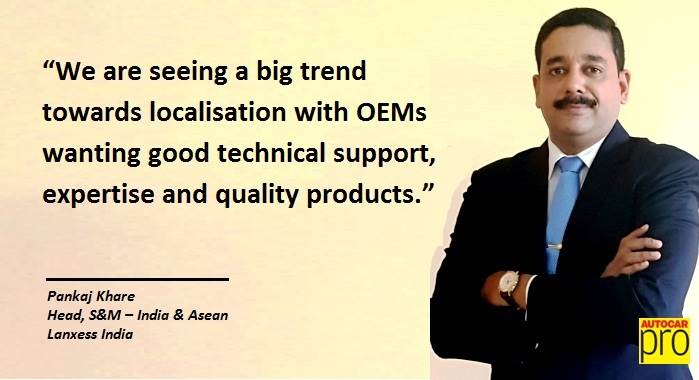
Adoption of plastic in two-wheelers is increasing. Where do you see a bigger opportunity – in two-wheelers or passenger cars?
There is huge potential in both the passenger car as well as the two-wheeler segments. We have been in the passenger car segment for many years. In India, we have been working with major two-wheeler manufacturers to convert many metal parts like the grabhandle, footrest, air intake manifold, fenders and cylinder head cover to plastics.
What are the opportunities and challenges you see in India?
India is a huge opportunity with a young population with more disposable income, a growing middle class and skilled manpower that helps deliver competitive products.
The government’s support to the auto industry is also adding value. OEMs in India demand expertise and experience in polymer science, application development along with local manufacturing presence in India. We are the ideal partners for them.
The challenges in India are the circumstances which are beyond our reach. An event like the erstwhile ban on diesel vehicles in Delhi or a sudden rise in dollar-rupee exchange rates that was seen in mid-2013 are two examples.
We start working with OEMs and Tier 1s at an early stage and the development cycle sometimes is as large as 2-3 years. Events happening at the end of a development cycle or start of production of vehicle are sometimes beyond our control but do have influence on our business.
This feature was first published in Autocar Professional's November 1, 2016, 'Lightweighting Special' issue.
RELATED ARTICLES
BRANDED CONTENT: Serving India’s EV ecosystem
Shimnit Integrated Solutions Pvt. Ltd. (SISPL), a subsidiary of Mumbai's leading high-security number plate supplier, Sh...
Driving EV business with agility and flexibility
CEOs from the EV startup ecosystem met in Bengaluru and Pune to discuss the challenges and business opportunities.
BRANDED CONTENT: SM Auto and Gotech energy inaugurate their first battery pack assembly plant in Pune
Pune-based SM Auto Engineering (SMA), a leading automotive component system manufacturer and its partner Gotech Energy (...





 By Kiran Bajad
By Kiran Bajad
 16 Nov 2016
16 Nov 2016
 9545 Views
9545 Views



